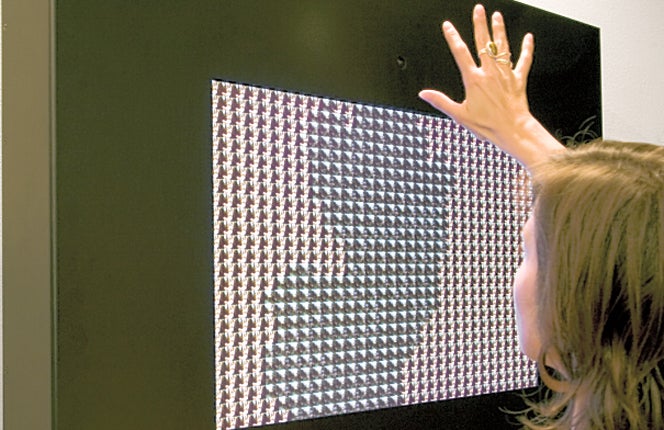Recorders: Rafael Lozano-Hemmer, Manchester Art Gallery

At first, the large, low-lit gallery space looks rather unprepossessing: a circle of vintage microphones, all spot-lit, stand at its centre, as if waiting for a 1960s variety show to start. But where are the contestants? In the room's far corner, there's a long table that resembles an airport scanner (its surface, brilliantly lit with white light, is moving and moving). What else? Not much. A wall-hung mirror waits patiently for a human stare. When you look into it, with the usual degree of curiosity mingled with apprehension, you see the predictable sadness of yourself. But you see something else too: a word has been blazoned in light across your forehead: autopoiesis (auto-creation). How has that happened? Elsewhere, a series of tiny green computer screens, also wall-hung, are connected to each other by a tangled skein of wiring. Each screen has a bizarre question. Otherwise, nothing is happening. The room is utterly soundless. Is this all there is?
In other rooms it is much the same story. Nothing happens here unless you make it happen. Frank Stella once said that what you see is what you get. The message of this show by the Canadian-Mexican artist Rafael Lozano-Hemmer is: what you give back is what you get. He uses technology, old and new – from the microphone to the fingerprint scanner – to project back at us our own bodily responses. That's the art here. To stare at the consequences of what our own bodies are doing as we stand here, trying to figure out what this exhibition is all about. The work only comes into being when we interact with the various kinds of digital technology that Lozano-Hemmer has manipulated to survey our responses. It feels very low-key, but also very invasive. It is as if we are being spied upon – by ourselves.
So step up to one of those microphones and see what happens. You speak into it, expecting to hear your own voice amplified. You hear a tiny snatch of yourself, but you also hear other voices that have spoken into this same microphone. If a group of you stand in a circle and speak all at once, it's as if you are listening to a crowd of absent witnesses to what you are saying. The artist has embedded a recording device into each of the microphones so that the voices of thousands of earlier speakers can be heard too.
Lozano-Hemmer's art is all about technology and subtle subterfuge. One room, the largest of all, consists of light bulbs, hung above our head in rows. At one end of the room, there are two parallel bars that, when you grip them, measure your pulse rate. This reading is immediately transferred to a light bulb, which begins to flicker on and off at the rate of your own pulse. Each bulb in this room measures a different human pulse rate. We crick our necks and admire evidence, in the form of all this lovely, irregular patterning, of our own mortality.
As we enter the exhibition, we are invited to stick our index fingers into a tiny metal orifice beside a screen. The pulse rate of our finger is being measured. The screen displays an image of our pulsing finger end, hugely magnified, and images of other pulsing fingers too, hundreds of them, diminishing in size as our eyes travel up the screen. Our own petty lives have been transformed into a theatre of ever shifting electronic possibilities. We feel unnerved, diminished, troubled, excited.
To 30 January (0161 235 8888)
Join our commenting forum
Join thought-provoking conversations, follow other Independent readers and see their replies
Comments